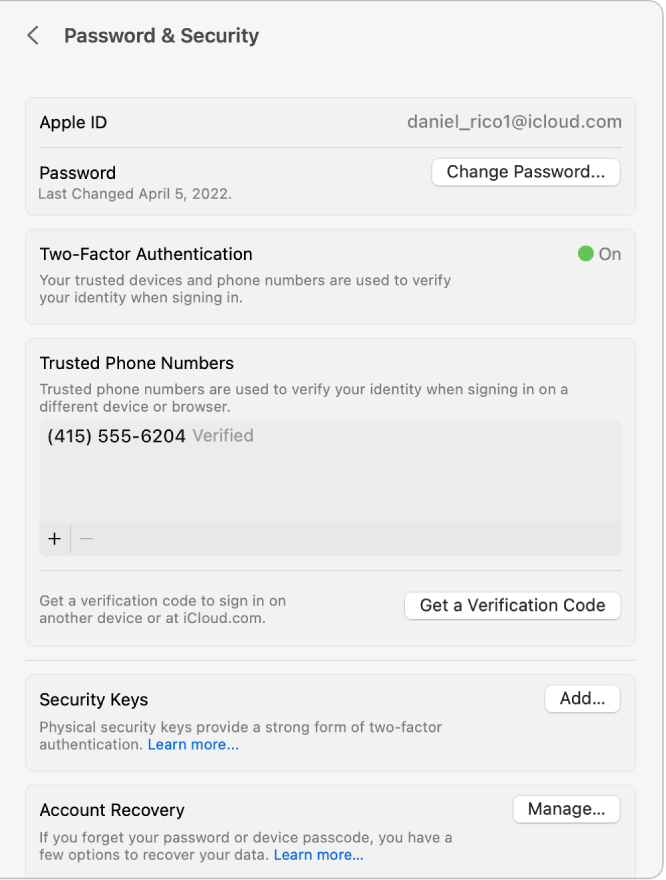
Set up your Apple ID password and security information on Mac
You use Apple ID Password & Security settings to change the security settings associated with your Apple ID.
On your Mac, choose Apple menu

If you don’t see your name, click Sign in with your Apple ID to enter your Apple ID or to create one.
Click Password & Security on the right, then view or change the following:

Apple ID: View the email address associated with your Apple ID. In some locations, you can use a phone number instead of an email address. See the Apple Support article Use your mobile phone number as your Apple ID.
Password: Click Change Password to change your Apple ID password, which protects the information associated with your Apple ID. This information includes payment and shipping information, iCloud information, media and purchase information, and more. See Learn how passwords are used on Mac.
Two-Factor Authentication: Indicates if your Apple ID has two-factor authentication turned on.
If two-factor authentication is on and you need a verification code to sign in on another device or at iCloud.com, click Get a Verification Code.
If two-factor authentication is off and you want to turn it on, click “Turn on.”
You can also turn two-factor authentication on and manage your trusted devices and phone numbers by signing in to your Apple ID account page.
Trusted phone numbers: If two-factor authentication is on and you want to add trusted phone numbers, click the Add button
 , then enter your Mac login password when asked. Next, type a phone number that can be used to verify your identity. Select whether you want to be reached by text or phone call, click Continue, then enter the verification code sent to the phone number you added.
, then enter your Mac login password when asked. Next, type a phone number that can be used to verify your identity. Select whether you want to be reached by text or phone call, click Continue, then enter the verification code sent to the phone number you added.You must verify at least one trusted phone number when you enroll in two-factor authentication. You should also consider verifying other phone numbers you can access, such as a home phone, or a number used by a family member or close friend. Trusted phone numbers don’t automatically receive verification codes. If you temporarily can’t access your own devices, click or tap “Didn’t get a verification code?” on the new device, then choose one of your other trusted phone numbers to receive the verification code.
Get a verification code: If two-factor authentication is on and you need a verification code to sign in on another device or at iCloud.com, click Get a Verification Code to generate a code. (This option doesn’t appear if you have security keys.)
Security keys: Add physical security keys to your account for a stronger form of two-factor authentication. See Use security keys for two-factor authentication.
Account Recovery: Choose up to five people you know and trust to become account recovery contacts. If you ever get locked out of your account, a recovery contact is someone who can verify your identity and help you regain access, without being able to access your account and data themselves. You can choose one of your contacts, or if you use Family Sharing, a member of your Family Sharing group. To set up a recovery contact, click Manage, then click the Add button
 . Click Add Recovery Contact, then follow the onscreen instructions. See the Apple Support article Set up an account recovery contact.
. Click Add Recovery Contact, then follow the onscreen instructions. See the Apple Support article Set up an account recovery contact.You can also set up a recovery key to increase the security of your account. Click Manage next to Account Recovery, click Manage next to Recovery Key, click Turn On, then follow the onscreen instructions.
Legacy Contact: Designate people who will be able to access your Apple account data in the event of your death. Your Legacy Contact can be anyone you choose—they don’t even need an Apple ID or an Apple device. To designate a legacy contact, click Manage, click Add, then follow the onscreen instructions. See the Apple Support article How to add a Legacy Contact for your Apple ID.
Automatic Verification: Bypass CAPTCHAs in apps and on the web by allowing iCloud to automatically and privately verify your device and account.
Apps Using Your Apple ID: This option only appears if you’ve used Sign in with Apple to set up an account on an app or website. Click Edit to see a list of apps and websites that you’ve signed in to using Sign in with Apple. The options provide information about your accounts and the ability to turn off features or stop using Sign in with Apple. See Use Sign in with Apple.
For information about changing your Apple ID account information on the Apple ID website, see your Apple ID account page.
For information about changing Apple ID account settings using an iOS or iPadOS device, see “Manage Apple ID settings” in the user guide for iPhone, iPad, or iPod touch.